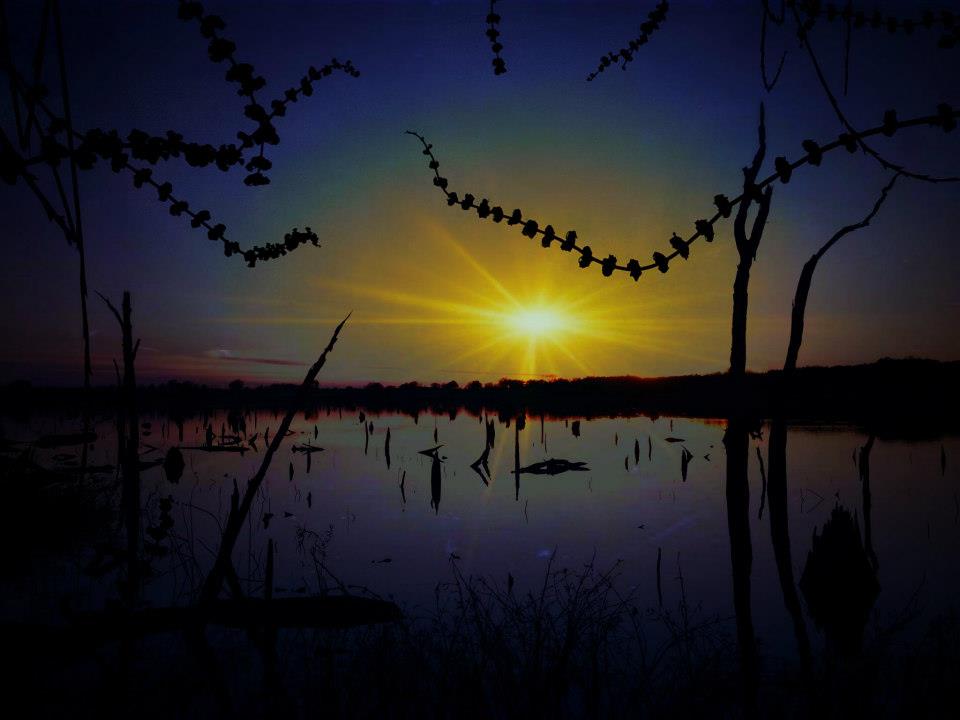
A pond where fracking waste is stored in Oklahoma. Photo by Linda Stokes / Facebook
Jay Daniels of Round House Talk wonders what's really going on with all of those earthquakes in Oklahoma:
According to the USGS, since the beginning of 2014, here are the top 5 states with increased earthquakes: Number 5 is the state of Idaho who has had 22 earthquakes with average magnitude 3.0 or greater;Get the Story:
Number 4 is the state of Montana which has had 31 earthquakes with an average of 3.0 or greater;
Number 3 is the state of Oregon which has had 47 earthquakes;
Number 2 is the state of California, with 182 earthquakes, and a magnitude of 3.0 or stronger; and
Number one isn't even close. Since January 1, Oklahoma has had 303 earthquakes with a magnitude of 3.0 or greater. It’s amazing Oklahoma has reported a significant number of earthquakes greater than California, who has been considered the state where an earthquake most likely would occur. Who would have ever guessed Oklahoma would not only have to worry about tornados, but also earthquakes. However Oklahoma’s earthquakes generally are of the 4.0 or less magnitude but strong enough to be felt many miles away from the epicenter and damage housing foundations. The problem is these earthquakes seem to occur regularly and in one recent day, the USGS has recorded seven small earthquakes shaking central Oklahoma in a span of about 14 hours. They ranged between 2.6 through 2.9. The volume and frequency of these earthquakes has many Oklahoma homeowners considering adding earthquake damage to their home insurance policies. The report is apparently holding to “the primary suspected source of triggered seismicity is not from fracturing, but from the injection/disposal of wastewater associated with oil and gas production. Produced water is naturally occurring water within the earth that is often high in salinity and co- exists with oil and gas in the subsurface. As the oil and gas is extracted/produced, so is the water. This water is then separated from the oil and gas through heating and re-injected into disposal wells. While there are large amounts of wastewater generated from fracturing, this volume represents part of the total volume of water injected into disposal wells in Oklahoma.”
Jay Daniels: A whole lot of shaking going on – who or what is the culprit? (Round House Talk 4/30) Federal Register Notice:
Oil and Gas; Hydraulic Fracturing on Federal and Indian Lands (March 26, 2015)
Join the Conversation
Related Stories
Editorial: DOI's new
fracking regulations strike the right balance (04/01) Opinion: Don't include Indian Country in BLM fracking regulation (3/30)
Interior Department includes tribal land in fracking regulation (3/20)
Native Sun News: Oil spill threatens North Dakota tribe's water (03/18)
Native Sun News: Tribe keeps wraps on tests of water after spill (03/09)
Editorial: New York governor makes right decision to ban fracking (12/18)
Winona LaDuke: Fracking bans needed across Indian Country (10/09)
Native Sun News: Tribes urged to ban fracking on reservations (08/12)
Jay Daniels: Concerns about fracking lie with disposal of waste (06/26)
Energy company vows complete disclosure of fracking fluids (04/25)
House committee approves Native American Energy Act (06/13)
DOI extends comment period on rule for hydraulic fracturing (06/06)
DOI defends inclusion of Indian lands in fracking regulation (05/24)
DOI releases update to fracking regulation on Indian lands (5/16)
